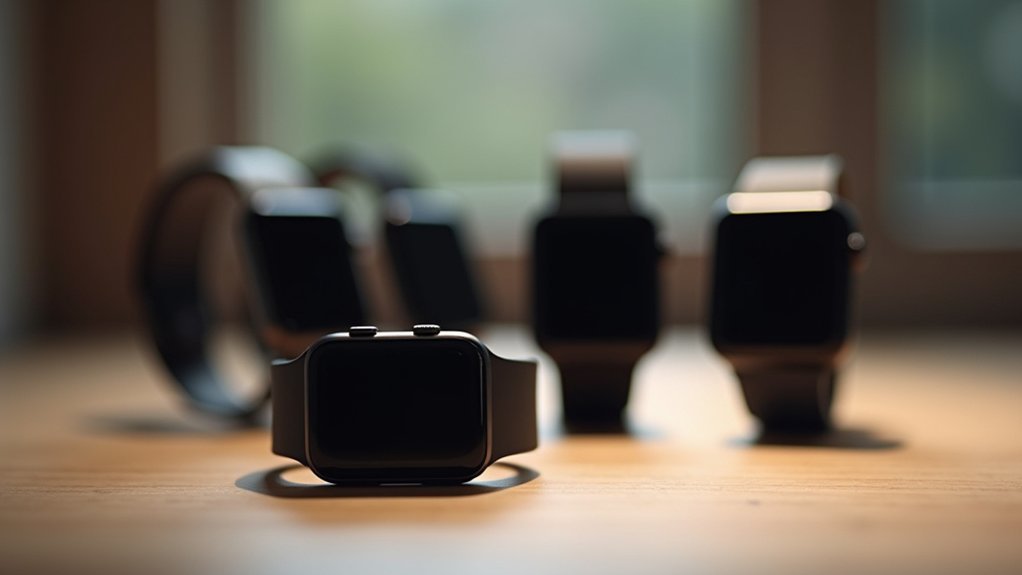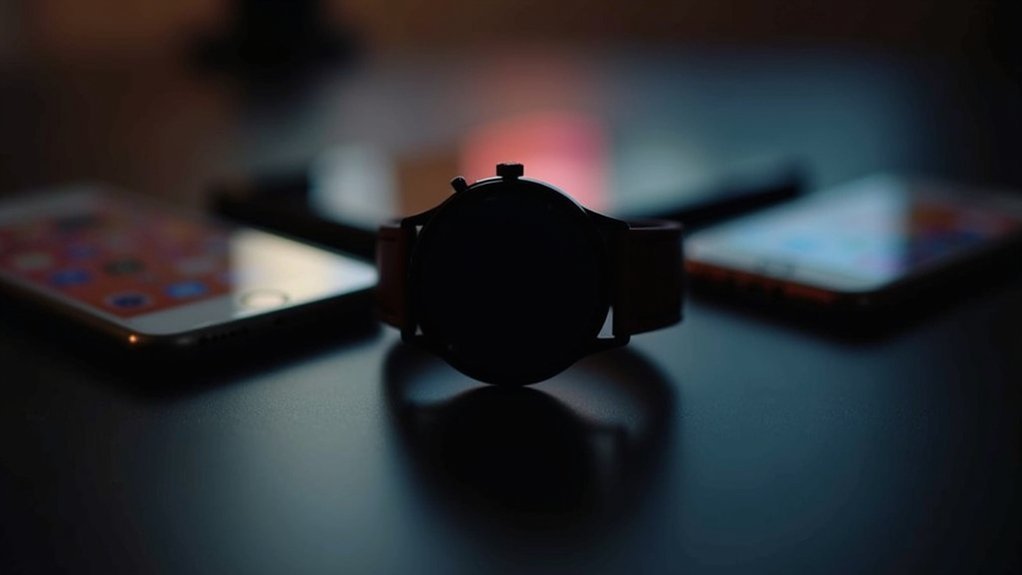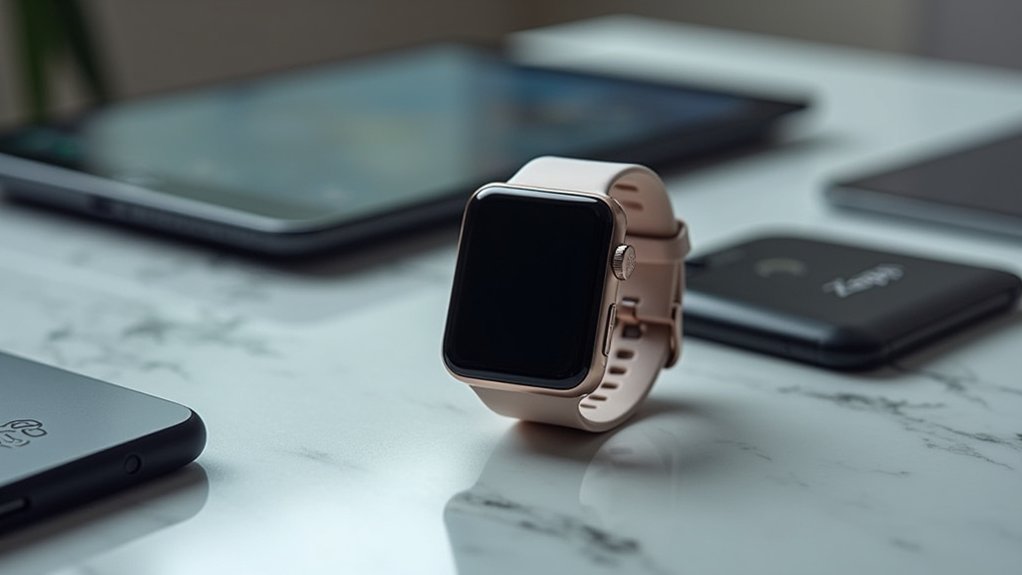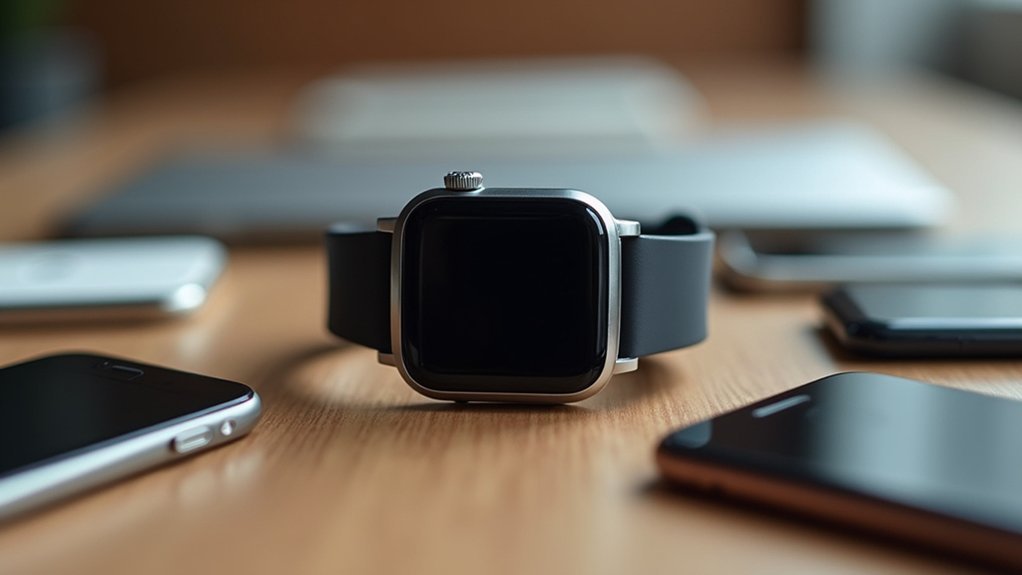Smartwatch operating systems determine your device compatibility and feature access across different phones. Apple Watch requires iPhone XS or newer with iOS 17, while Google Wear OS works best with Android but offers limited iOS functionality. Samsung’s One UI Watch enhances Android integration, and Zepp OS provides true cross-platform support for both ecosystems. You’ll face messaging, calling, and performance trade-offs when pairing across different platforms, so choosing the right OS for your mobile ecosystem guarantees peak functionality and battery life.
Understanding Smartwatch Operating System Landscape in 2025

How do you navigate the complex world of smartwatch operating systems when choosing your next wearable device? Understanding the major platforms helps you make informed decisions.
Wear OS dominates the Android ecosystem, powering devices like Google Pixel Watch 3 and offering Google Assistant, Maps, and Wallet integration.
Samsung’s One UI Watch runs on Wear OS but adds Galaxy AI features for enhanced wellness insights.
OnePlus combines standard Wear OS with proprietary software features through their dual-OS approach.
For cross-platform compatibility, Zepp OS works seamlessly with both Android and iOS devices, primarily found on Amazfit smartwatches.
Garmin OS focuses specifically on fitness enthusiasts, delivering outdoor activity tracking that works across platforms. Many smartwatches require daily charging due to their advanced features and processing demands.
Each system offers distinct advantages depending on your smartphone ecosystem and usage priorities.
Apple Watchos Compatibility Requirements and Limitations
When you’re considering an Apple Watch, understanding the strict compatibility requirements becomes essential since Apple’s ecosystem operates within specific parameters.
You’ll need an iPhone XS or later running iOS 17 to use watchOS 10, which supports Apple Watch Series 4 and newer models, including all SE versions and Ultra models.
However, you’ll face several limitations that could impact your experience:
Several key limitations may significantly affect your Apple Watch experience and overall functionality.
- Device age restrictions – Series 3 and older models no longer receive updates
- iPhone dependency – Your Apple Watch can’t function fully without a compatible iPhone
- Geographic limitations – Certain features like blood oxygen measurements aren’t available everywhere due to regulations
- Hardware constraints – Older supported models may not access all new features
- Update requirements – You must maintain the latest compatible iOS version for watchOS updates
Looking ahead, Apple Watch Series 6 owners should be aware that their devices may lose compatibility with future updates, as Apple typically discontinues software support after five years of device availability.
Google Wear OS Performance Across Different Mobile Platforms

While Apple Watch maintains its closed ecosystem approach, Google’s Wear OS takes a fundamentally different strategy by offering cross-platform compatibility that extends beyond Android devices to include iOS integration.
You’ll experience peak performance when pairing Wear OS with Android smartphones, gaining seamless app sharing, notification management, and full Google service integration. The platform delivers efficient Bluetooth connectivity, smooth app execution, and full-day battery life across various manufacturer devices.
However, you’ll encounter limited functionality when connecting to iOS devices. While basic notifications work, you’ll miss advanced customization options and extensive app support that Android users enjoy.
iOS restrictions also limit Google service integration. Despite these constraints, Wear OS 5.0’s enhanced performance guarantees reliable operation regardless of your mobile platform choice. All Wear OS apps must target Android 13 or Android 14 by August 31, 2024, ensuring modern compatibility standards across devices.
Samsung One UI Watch Integration With Android Devices
Samsung’s One UI Watch transforms your Android smartwatch experience by building upon the Wear OS foundation while delivering Samsung’s distinctive interface design and ecosystem integration.
You’ll find seamless compatibility across Android devices, not just Samsung smartphones. The platform leverages Wear OS’s robust infrastructure while adding Samsung’s signature features and visual elements.
Key integration benefits include:
- Advanced health insights with detailed fitness tracking and analysis tools
- Personalized watch faces offering modern designs and customizable themes
- Effortless navigation through Samsung’s intuitive interface enhancements
- Third-party app support expanding functionality beyond Samsung’s ecosystem
- Regular software updates introducing new features and improved performance
The Galaxy Watch ecosystem extends Samsung’s device tracking capabilities, allowing you to locate and monitor your smartwatch alongside other Samsung devices through the Samsung Find app.
Future updates promise even deeper integration, including Google’s Live Updates feature and AI-driven Gemini Actions, ensuring your Galaxy Watch remains cutting-edge regardless of your Android device choice.
Zepp OS Cross-Platform Functionality and Device Support

You’ll find Zepp OS offers impressive cross-platform functionality, working seamlessly with Android, iOS, Windows, Mac OS, and Linux systems.
Your Amazfit smartwatch running Zepp OS delivers exceptional battery life that outperforms many competitors, though you’ll need to weigh this against certain feature limitations compared to more established platforms. The development environment includes a simulator that supports cross-platform functionality across Windows, Mac OS, and Linux systems for enhanced testing capabilities.
Understanding these trade-offs between extended usage time and available functionality will help you determine if Zepp OS aligns with your smartwatch needs.
Device Compatibility Across Platforms
Although Zepp OS currently ranks third among smartwatch operating systems behind Apple’s watchOS and Google’s Wear OS, it delivers robust cross-platform functionality that sets it apart from competitors.
You’ll benefit from Zepp OS’s extensive device compatibility across multiple platforms. The system’s partnership with AMETEK Crank’s Storyboard framework enhances your user experience while maintaining consistent performance across different hardware configurations.
Key compatibility advantages include:
- Multi-platform support – Works seamlessly across Windows, Mac OS, and Linux systems
- GUI application reusability – Applications transfer easily between hardware platforms with minimal adjustments
- Hardware scalability – Maintains cohesive user experience across various device specifications
- Cross-platform development tools – Simulator supports extensive development across all supported platforms
- Gadgetbridge integration – Provides additional features and expanded device compatibility options
The platform continues expanding its hardware support with new Amazfit Band 7 compatibility added in recent updates.
Battery Life Advantages
Battery efficiency stands as Zepp OS’s most compelling advantage, delivering up to five days longer usage compared to competing smartwatch operating systems.
You’ll experience optimized power consumption through efficient algorithms that maximize battery performance even with smaller capacities. The Amazfit Bip 5 exemplifies this efficiency, providing 10 days of typical use and extending to 30 days in battery saver mode.
You can customize power management settings based on your preferences while maintaining consistent performance across different models.
Zepp OS enables continuous health monitoring without frequent charging interruptions, making it ideal for long-term data collection. The latest generation devices showcase even greater efficiency, with the Balance 2’s 658 mAh battery delivering up to 21 days of extended usage.
Whether you’re using an Amazfit Balance 2 or GTS 3, you’ll benefit from advanced power management capabilities that guarantee reliable, extended usage across the entire device ecosystem.
Feature Limitations Vs Benefits
While Zepp OS offers impressive customization capabilities through its widget system and personalized UI design, you’ll encounter significant compatibility constraints that limit cross-platform functionality.
Mini Programs developed for Zepp OS 2.0 won’t work on devices running version 1.0, requiring separate development approaches. You’ll find that newer features enhance functionality but exclude older devices that can’t support upgrades. The system also supports Bluetooth connectivity for integration with external devices like cadence sensors to enhance motion analysis accuracy.
Key limitations and benefits include:
- Storage constraints limit music to 2.3GB and membership cards to 20 per account
- Real-time monitoring provides heart rate, speed, and distance tracking for performance optimization
- Workout extensions offer plug-in capabilities without requiring OTA updates
- BioTracker™ 5.0 sensor technology delivers enhanced health tracking accuracy on compatible devices
- Customization features remain mostly available only on newer OS versions
Ios Users Guide to Compatible Smartwatch Options
If you’re an iPhone user, you’ll want to understand how different smartwatches work with your iOS device before making a purchase.
The Apple Watch ecosystem offers the most seamless integration with your iPhone, but you’re not limited to Apple’s options alone.
Several cross-platform alternatives can connect to your iPhone, though they’ll offer varying levels of functionality and feature compatibility. Popular options like the Fitbit Versa 4 and Garmin Vivoactive 4 provide health monitoring capabilities while maintaining iPhone connectivity for notifications and basic smart features.
Apple Watch Ecosystem
When you own an iPhone, the Apple Watch represents your most seamless smartwatch option, offering deep integration that third-party wearables simply can’t match.
You’ll access the full watchOS ecosystem with native notifications, Siri functionality, and extensive health tracking that syncs directly with your iPhone’s Health app.
Your choice depends on specific needs and budget:
- Apple Watch SE ($249) – Budget-friendly option with essential features and 18-hour battery
- Apple Watch Series 10 ($399) – Latest health tech including sleep apnea detection and 36-hour battery
- Apple Watch Ultra 2 ($799) – Rugged build with 72-hour battery for outdoor enthusiasts
- Apple Watch Hermès ($1,249) – Luxury materials and premium craftsmanship
- watchOS 11.4 compatibility – Guarantees you’ll receive regular updates and new features across supported models
The Apple Watch has evolved significantly from its original purpose as a fitness tracker to become a comprehensive multifunctional device that handles everything from boarding passes to weather alerts.
Cross-Platform Alternative Options
Though Apple Watch dominates the iPhone ecosystem, you’ll find several compelling cross-platform alternatives that deliver solid smartwatch functionality without forcing you into Apple’s walled garden.
Samsung Galaxy Watch 7 Ultra offers sophisticated health tracking with some iOS limitations, while Google Pixel Watch 3 provides seamless notifications and basic app integration.
For budget-conscious users, Amazfit GTR 4 stands out at $199, featuring multi-band GPS, a 1.43-inch AMOLED display, and exceptional 14-day battery life.
TicWatch Pro 5 and OnePlus Watch 2 run Wear OS with iPhone compatibility, emphasizing battery efficiency and rugged durability. The TicWatch Pro 5’s dual display design significantly extends usage time to approximately 4 to 5 days between charges.
These alternatives support standard fitness tracking, voice assistants, and 5ATM water resistance, though mobile payment options remain limited compared to Apple Pay integration.
Android Users Best Smartwatch Choices and Features
Why settle for basic notifications when you can have a smartwatch that transforms your Android experience? As an Android user, you’ll find exceptional options that seamlessly integrate with your device’s ecosystem.
Your top choices include:
- Samsung Galaxy Watch Ultra – Features advanced running dynamics, virtual rotating bezel, and deep Samsung Health integration
- Pixel Watch 3 – Offers 60Hz AMOLED display, Fitbit services, and tight Google Assistant integration
- OnePlus Watch 3 – Delivers robust features at a cost-effective price point
- Google Pixel Watch Series – Provides seamless Google Maps and Wallet functionality
- Huawei Watch GT Series – Known for exceptional battery life and stylish design
You’ll enjoy features like VO2 Max tracking, contactless payments through Google Wallet, and voice control with Google Assistant or Bixby, depending on your chosen device. These recommendations come from extensive testing that includes weeks to months of product evaluation across battery life, display quality, durability, and health tracking capabilities.
System-Agnostic Smartwatch Solutions for Multi-Device Households
If your household runs on different operating systems, you’ll need smartwatches that bridge the Android-iOS divide without forcing everyone to switch platforms.
Fitbit OS leads this space, offering seamless health tracking and data sync across both ecosystems. Garmin’s proprietary OS excels at notifications and health metrics regardless of your phone choice. Samsung’s recent Galaxy watches now support iPhone users, though with some feature restrictions.
Cross-platform apps like Strava, Spotify, and AccuWeather maintain consistent experiences across devices. You’ll rely on companion apps for setup and updates, but most major brands offer these on both Google Play and App Store. Professional development teams utilize battery optimization techniques to ensure these cross-platform solutions maintain extended usage across different operating systems.
Some models support family setup options and shared health data, making them ideal for mixed-platform households seeking unified wearable experiences.
Feature Restrictions When Pairing Across Different Platforms
When you pair a smartwatch with a non-native platform, you’ll immediately notice significant messaging and call limitations that disrupt your communication flow.
Your Apple Watch won’t access iMessage or Siri on Android, while cross-platform health data sync becomes unreliable or completely unavailable. Additionally, essential features like Apple Pay become completely inaccessible when using your watch with Android devices.
These restrictions force you to rely on workarounds that drain battery life and eliminate key features you’d expect from your smartwatch.
Messaging and Call Limitations
While smartwatches promise seamless connectivity across devices, pairing an Apple Watch with an Android phone creates considerable messaging and call limitations that can frustrate daily users.
You’ll encounter major obstacles when trying to communicate through your Apple Watch-Android combination:
- SMS and MMS support becomes unreliable, with messages often failing to sync properly between devices.
- Cross-platform messaging apps like WhatsApp or Signal lack native integration, forcing you to rely on limited third-party workarounds.
- Incoming call notifications may appear inconsistently due to platform compatibility issues.
- Outgoing call functionality is severely restricted without direct iOS integration.
- iMessage remains completely inaccessible to Android users, eliminating Apple’s primary messaging ecosystem.
These communication barriers considerably compromise the smartwatch experience, making basic functions cumbersome and unreliable for cross-platform users. Without the Watch app available on Android, users cannot establish proper notification mirroring from their phone to the Apple Watch.
Health Data Sync Issues
Beyond communication hurdles, pairing smartwatches across different platforms creates notable health data synchronization problems that undermine one of these devices’ most valuable features.
Samsung Health restricts activity data sharing when you set up your watch independently from phone pairing. Apple Watch delivers seamless sync within iOS but disables advanced health features when paired with non-Apple phones.
WearOS devices connected to iPhones experience reduced functionality, including incomplete health metrics and missing workout data.
You’ll encounter partial data transfer where certain health metrics aren’t supported across platforms. Cross-platform sync often lacks real-time updates, requiring manual refresh to see your latest fitness information. Additionally, network connection issues can further disrupt the synchronization process between devices.
These limitations considerably reduce the thorough health tracking experience you’d expect from modern smartwatch technology.
Battery Life and Performance Trade-offs in Cross-Platform Usage
As you explore cross-platform smartwatch options, you’ll discover that battery life and performance create a delicate balancing act that directly impacts your daily experience.
When using Wear OS watches across Android and iOS platforms, you’ll face trade-offs that affect functionality and longevity.
Your smartwatch’s performance varies considerably based on platform compatibility:
Cross-platform compatibility significantly impacts your smartwatch’s battery life, processing efficiency, and available features depending on which device ecosystem you’re using.
- Feature limitations reduce battery drain when certain ecosystem-specific apps can’t fully integrate
- Processing demands increase when cross-platform syncing requires additional background operations
- Power-saving modes become essential for extending usage but disable smart features you might need
- Charging frequency changes based on which platform features remain active during cross-platform use
- Performance optimization differs between platforms, affecting overall efficiency and battery consumption
Understanding these trade-offs helps you make informed decisions about smartwatch selection. The OnePlus Watch 2’s Wear OS Hybrid Interface specifically addresses battery efficiency challenges by utilizing a low-powered coprocessor to handle background tasks during cross-platform operations.
Choosing the Right Smartwatch for Your Mobile Ecosystem
Understanding these performance considerations naturally leads to the most important decision: selecting a smartwatch that works seamlessly with your specific mobile platform.
If you’re an Android user, you’ll have the widest selection available. Samsung Galaxy watches offer excellent integration with Android phones, though you’ll need to verify your phone runs the required Android version and RAM specifications. Most Wear OS watches work exclusively with Android devices.
iPhone users face more limited options, but don’t despair. The Fossil Gen 6 stands out as a rare cross-compatible Wear OS 3 smartwatch supporting both Android and iOS. The TicWatch Pro 3 Ultra also maintains cross-platform compatibility with both iOS and Android devices.
Alternatively, consider fitness-focused brands like Fitbit and Garmin, which typically sync well with both Apple Health and Android Health Connect through their dedicated apps.
Always verify device-specific compatibility requirements before purchasing to avoid disappointing surprises.
Frequently Asked Questions
Can I Switch My Smartwatch Between Iphone and Android Without Losing Data?
You can’t switch your smartwatch between iPhone and Android without losing data. Different ecosystems don’t sync together, so you’ll need to factory reset and lose stored health data, settings, and apps.
Do Smartwatch Apps Purchased on One Platform Work on Another Platform?
You can’t transfer smartwatch apps between platforms. Apps purchased on Apple Watch won’t work on Wear OS or Samsung watches. You’ll need to repurchase compatible versions for each platform.
Will My Smartwatch Receive Updates if I Change Phone Operating Systems?
Your smartwatch will continue receiving updates if you change phone operating systems. Updates come from your watch’s manufacturer through its own OS, not your phone’s system, so switching phones won’t affect them.
Can Family Members Share One Smartwatch Across Different Phone Brands?
You can share an Apple Watch among family members using different phone brands through Family Setup, but it requires an iPhone for initial configuration and offers limited functionality when paired across iOS and Android ecosystems.
Do Fitness Tracking Accuracies Differ When Using Cross-Platform Smartwatch Compatibility?
You won’t see significant fitness tracking accuracy differences from cross-platform compatibility. Your smartwatch’s sensor quality and algorithms determine accuracy more than whether you’re pairing Android with iOS devices.
In Summary
You’ll find that choosing the right smartwatch depends heavily on your mobile ecosystem. If you’re deeply invested in one platform, stick with its native option for the best experience. However, if you switch between devices or share with family members, consider system-agnostic options like Garmin or Fitbit. Don’t forget to weigh feature limitations and battery compromises when crossing platforms—convenience often comes with trade-offs you’ll need to accept.





Leave a Reply